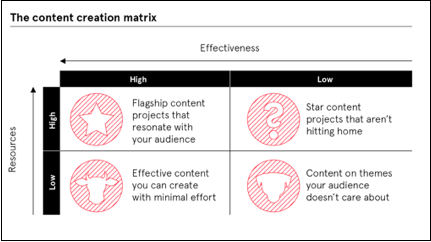ChatGPT wants my job. It can’t (and it won’t) have it.
Time to read: 4 minutes
As a professional and experienced copywriter, AI and how it will come to influence humanity has been the cause of much recent existential dread for Anthony McNamara, content creator at The Comms Crowd. In this post he looks at the risks and benefits of ChatGPT and what it is really in store for us.
 As a professional and experienced copywriter, AI and how it will come to influence humanity has been the cause of much recent existential dread. Admittedly, binging on every documentary and podcast the topic has to offer, all with contributions from long-time experts in the field, did little to assuage my fears.
As a professional and experienced copywriter, AI and how it will come to influence humanity has been the cause of much recent existential dread. Admittedly, binging on every documentary and podcast the topic has to offer, all with contributions from long-time experts in the field, did little to assuage my fears.
Initially, the dread was far-reaching. The speed with which AI continues to develop is raising questions those in power don’t even know exist, let alone know how to answer. Approaching its adolescence, the advent of Artificial General Intelligence (AGI) – a term suspiciously innocuous – will mark the technology’s passage into maturity and the point at which our dependency on robotic intelligence will begin its final phase.
It will mark the most significant point in human history since the first homo sapiens discovered how to create fire. AGI, however, will be a blaze we could all too easily lose control over forever. Hence the recent dread.
The dread gets real
When ChatGPT trampled onto the scene like a heavily caffeinated Wildebeest in a pensioners’ yoga class, I admit to not thinking too much of it. “Another AI service that I can spend my free time interrogating on whether 4-4-2 or 4-3-3 is the more effective football formation. Big wow.”
But then I used it, and the cold beads of sweat began forming on my expansive brow.
The solution I opted for, Bearly.AI, offers a variety of ‘prompts’, one of which is called ‘Copy Wizard’ for essays, blogs, and posts. I typed in a made-up, generic title and sat back in horror as the tool generated a grammatically sound and, on the face of it, relevant 1,000-word blog.
If it was dread I was experiencing before, I wouldn’t even know what the word is to describe what I experienced at that moment.
It was a feeling that lasted for weeks. The gig is up. Time to start thinking about re-training.
The importance of knowing your enemy
Having sought reassurance from a selection of family members, friends, and colleagues, I unearthed my resolve. I love my job, and I’m not losing it to a set of cocky algorithms.
It was time for me to step into the ring with ChatGPT, and we were going bare knuckle.
Instead of using some generic blog title, I re-engaged Bearly.AI and typed in the title of an actual blog a real client had asked me to write. The blog outline immediately separated into different sections and looked depressingly appropriate. Next, I clicked the ‘Generate Copy’ button, and within around 30 seconds, the full blog cascaded down my screen.
But then I began reading it, and the sense of elation was almost transcendental. The blog was crap.
It was littered with repetition, from sentence openers to entire sentences. It had zero personality. And, it was laughably light on illuminating facts and figures — just crap.
Friend, not foe
With round one going emphatically to the human, I began to recalibrate my whole attitude toward ChatGPT. Its ability to produce quality content is limited, to put it politely, but it offers other functions that have since proved to be handy.
The ‘Continuation’ prompt designed to help beat writer’s block has merit, as does the ‘Executive Summary’ and ‘Counter Argument’ prompts. In fact, it turns out that learning how to construct the best prompts is arguably the most important skill you can acquire when using ChatGPT-enabled tools.
True though this may be, even with the most ChatGPT-friendly prompts inputted, the resultant copy is not what any self-respecting copywriter or organisation would ever think to submit, much less, publish. But it can give a decent starting point, a handy blueprint for something a competent human can radically improve upon.
In other words, ChatGPT can be thought of as a promising work-experience student approaching their employer and saying, “Hi, I’ve done this for you to try and save you a bit of time.” And I, the employer in this dubious analogy, reply with, “Thank you. I can probably use some of this. Now you run along and finish transcribing that video for me.”
Even if ChatGPT does become a little too self-assured in the future, it faces another problem even more formidable than me.
The search engines won’t stand for it
When the likes of Google cottoned on that people were stuffing their websites with key words as a means of doping their SEO, the backlash was ruthless. Many websites were penalised so heavily with SERP (Search Engine Results Page) relegations, they never properly recovered.
Expect the same for AI content. Indeed, a raft of AI content detector tools are already sweeping the marketplace and it seems to be a matter of time before they’re integrated into search engine result generators.
The last thing any search engine provider wants is for its users to be pummelled with a load of robot content during their cyber surfing sessions.
Apart from the inevitability of this development is the delicious irony – AI saving the livelihoods of copywriters from AI. *chef’s kiss*.
ChatGPT knows its place. For now.
I don’t know what the future holds for ChatGPT. That’s the one thing that’s still quite scary – no one really does.
However, I do know that in its present form, it can’t respond to detailed briefs anything like as ably as a human copywriter. It can’t understand the unspoken reactions of clients during calls. It can’t offer original insight on any topic, question a client’s approaches or ideas, and it can’t inject personality unless it’s pretending to be someone else.
Mercifully, it also seems to understand all of this. With ChatGPT draped against the ropes, sweating and bloodied, I asked it directly if it was coming for my job.
Its response?
“As an AI language model, I don’t have the ability to predict the future. However, it’s unlikely that ChatGPT or any other AI language model will completely replace copywriters. While AI can be helpful in generating content and assisting with certain tasks, copywriting involves creativity, critical thinking, and a deep understanding of language and communication. These are skills that are difficult for AI to replicate, and human copywriters are likely to remain an important part of the industry.”
Maintain that attitude, ChatGPT, and you and I will get along just fine.
Let’s talk shop
Three tips to get intentional about your start-up’s culture
Time to read: 2 minutes
Emma Tucker, our newest team member and Internal Communications Consultant at The Comms Crowd provides her top three tips for creating a company culture that is the right for you. 
All companies – regardless of how long they have been running – have a culture. Your culture is that certain something that captures the essence of who you are and how you do things. It’s the thing that attracts people to join you and it’s also what keeps them working effectively and loyally.
For start-ups, your culture and vision are probably the two things that you can use to convince those first few hires through the door. So arguably, taking an intentional approach to define and use it is smart and will keep you honest as you grow. Here are three ways to get intentional with your culture.
1. Define it. Get your people in a room and discuss what makes the company what it is or what you want it to be. Write it down. Get specific on the words you choose and don’t be afraid to disagree; it’s in the debate that you’ll uncover areas of tension and uniqueness. Think about the stories that you each tell about your company – what do they say about you?
Be sure to define the values and behaviours that you want to live by. For example, you might choose “Impact” as a value and explain the accompanying behaviours as “You accomplish important work that positively impacts our clients” “You consider the impact of your work on the people around you” and “You leave a good impression because you take action and deliver on your promises.”
Then test it. And better yet, get more people in your company involved in the process. Let them discuss the values and pick behaviours that are relevant and helpful to their work. Get their input and the behaviours will stick.
Then test it with your clients and external stakeholders. Honest feedback will be your friend.
Keep refining the descriptions until they feel right and truly reflect what you’re all about. Aim to define four or five company values. Teams can then decide on the accompanying behaviours relevant to them (aim for three behaviours per value).
2. Embed it. That means weaving it into every interaction with your employees and clients. It should be part of how you hire, develop, and measure your people. It should become integral to the way you innovate and grow your business offering. It should be part and parcel of how you show up to client meetings and deliver results.
It should be reflected in your communications, both in the tone and in the method; instantly recognisable in everything from financial updates, processes and procedures, town halls, team meetings and one-to-one conversations. Ultimately your culture should dictate how you measure your performance and success.
3. Evolve it. Your culture is alive and will continue to evolve whether you maintain it intentionally or not. So, revisit the definitions – a fitting set of values and behaviours in year one might require a different nuance in year five. Check that you haven’t missed an important touchpoint as you’ve grown.
Smart leaders keep their finger on the pulse so go back to your employees and clients and listen again to their stories, observe their behaviour, and act on their feedback.
The speed and scale of your growth will dictate the frequency of these checkpoints, but every six months is a sensible guide.
This is time-consuming work but well worth the effort because getting intentional about your culture, will ultimately drive better business outcomes. McKinsey’s Organisational Health Index shows that organisations with top-quartile cultures post a 60% higher shareholder return than median companies and 200% higher than those in the bottom quartile.
People who want to positively add to your culture will perform better, more easily adapt to change, and help you to attract more talent. They will be your champions.
And putting in the effort to define, embed, and evolve your culture during the early years of your start-up, will save you a lot of time, money, and energy in the long run.
Let’s talk shop
Corporate culture: If you’re going to improve it, talk about it
Time to read: 4 minutes
Anthony McNamara, content creator at The Comms Crowd looks at why it is important for companies to talk about their corporate culture and values and why it is should be part of their communications plan.
 For any business to perform at optimal levels, designated KPIs must be monitored and assessed regularly. Typically, these KPIs surround functions such as sales, technology infrastructure, PR and marketing, and client relationships.
For any business to perform at optimal levels, designated KPIs must be monitored and assessed regularly. Typically, these KPIs surround functions such as sales, technology infrastructure, PR and marketing, and client relationships.
Critical though such metrics are, they are the supporting walls and lintels of the corporate edifice, and without a solid foundation, they are liable to collapse.
Sitting beneath the processes, goals, and assets of a successful business, that foundation takes its form as the corporate culture. Often neglected in favour of more short-term pursuits, developing a strong, inclusive, and supportive culture is the key to unlocking maximum potential.
However, simply embedding such a culture is not enough if you want to really reap its rewards; you have to talk about it.
In this blog, we look at the benefits of a great corporate culture, how The Comms Crowd clients have developed theirs, and how we helped them spread news of their successes to the masses.
The ‘Great Resignation’ has put corporate culture to the fore
If the development of a robust corporate culture was important before the Covid-19 pandemic, it became critical in the years that followed.
In what became known as the ‘Great Resignation’, employees voluntarily resigned from their jobs in unprecedented numbers and in the UK, between July and September 2021 alone, over 400,000 workers left their jobs.
Among the cited reasons employees gave for leaving were hostile working environments. Indeed, such was the prevalence of the reported phenomenon, that ‘toxic workplaces’ became a trending topic nationwide.
It is clear that the massive disruption of the last few years prompted fresh expectations among the workforce as to what behaviours they will and will not tolerate. A poor or neglected corporate culture may have been grudgingly endured before the 2020s commenced. But times have changed.
Quorsus, a former Comms Crowd client and strategic financial services consultancy founded just before the pandemic started and now owned by Capgemini, led discussions on the dangers of a toxic company culture and how one might be avoided. Quorsus was established with a vow that theirs would be a corporate culture imbued with positivity and reinforced by core values from the start.
Within consultancies – where your people are your product – the importance of embedding such a culture and values cannot be overstated and goes some way to explaining the extraordinary success Quorsus has enjoyed.
With our help, their approach and their message was amplified across their sector and beyond.
A robust corporate culture breeds productivity
Ask any education professional, and they will confirm that praise is essential for a child’s development. The chemical reaction experienced from being told they’ve done a great job provides an immediate boost to a child’s sense of self-worth and encourages them to continue working hard so they might experience it again.
In other words, it has the power to supercharge their productivity.
Yet, something changes when we reach adulthood and enter the world of work. It’s as though we forget those reward centres exist and how powerful they are. Consequently, praise is often replaced by criticism and our inner child – still so easily motivated by encouraging words – begins to suffocate in a miasma of ruthless expectation.
It is short-sighted, to say the least. A national Workplace Culture Survey of US employees found that 63% of respondents claim that workplace culture directly impacts their organisation’s success.
Productivity also depends on the abundance of opportunity. When a former client and friend of The Crowd dxw, a leading employee-owned digital agency that works with the public and third sectors, launched its Returners’ Programme to help build a diverse, inclusive workforce, it broke new ground.
To ensure that dxw’s sector and potential stakeholders knew of its endeavours, the agency brought in The Comms Crowd to tell and disseminate their story. The coverage was such that dxw has become recognised as an expert provider not just of digital public services, but of opportunity to those who may have felt it had passed them by.
Together we made sure that the world knew of its leadership position in creating a positive, inclusive culture. Among various steps, this included becoming one of the first companies to introduce gender pronouns into their signatures.
dxw’s small size notwithstanding, the firm went on to win an array of company culture awards, helping to attract exceptional like-minded talent. An essential for any fast-growing technology enterprise.
Positive cultures promote development
Five years on and ‘The Great Resignation’ jolted many organisations into action because they didn’t want to lose their top talent. Recognising that avoiding high employee turnover requires more than just an amenable working environment, many firms put a renewed focus on facilitating professional development.
Ahead of any recruitment drive, senior leaders invariably begin reviewing factors such as pay scales, perks and benefits, and holidays. However attractive they’re able to make each perk, if the organisation is renowned as a place where careers stagnate, the drive is doomed to failure.
As such, building a positive culture requires embedding opportunity and routes to success at all levels of the business. The best cultures underpin this by making commitments to personal development as much as professional, properly rewarding achievements, and understanding of the importance of a healthy work/life balance.
Former client, JDX Consulting, acquired by Delta Capita, attributed their sustained global success to a carefully developed culture of inclusivity, coaching, and empowerment that allowed the firm to attract diverse, high-quality talent from all walks of life.
By entrusting The Comms Crowd with articulating and sharing their methodologies, JDX quickly became the corporate culture benchmark within their sector before their acquisition by Delta Capita.
We then went further by working with JDX to promote their Festival of Learning, a professional development programme set up by the firm’s HR division. The initiative gives employees the space and tools to grow professionally at their own pace and take control of their own career progress.
Showcase your corporate culture with The Comms Crowd
Our clients love us because we’re adept at getting their messages and successes out into the public domain and the publications their stakeholders engage with.
If you have invested time and money into developing a corporate culture that breeds energy, achievement, opportunity, and happiness, it deserves to be celebrated.
Moreover, potential talent, partners, investors, and clients want to know what you’ve done and are doing. Speak to The Comms Crowd today, and our internal comms consultant, PRs and writers can ensure they soon will.
Let’s talk shop
The Importance of Building Trust in the World of Regtech
Time to read: 2 minutes
Lauren Bowden, Fintech content lead at The Comms Crowd looks at the opportunities and challenges facing Regtech firms, and the role trust plays in ensuring future success.
When the term Regtech burst onto the scene around circa 2015, it was met with mixed reaction. Some took the cynical path – simply as spin for existing regulatory technology vendors who have been in the business for years to benefit from Fintech’s halo effect. Others saw it as a way for new start-ups to shake things up, offering more cost-effective and agile SaaS-based solutions to post-GFC problems.
Seven years later, with the market projected to reach around USD 33.1 Billion by 2026, countless players are thriving in all areas from tax to cannabis. Established vendors are now embracing the portmanteau with open arms and investing in more flexible forward-looking business models – few would dispute that Regtech is here to stay.
That said – there are still a fair few hurdles these firms need to jump before they can realise their full potential. According to the FCA, one of the most active regulators supporting this burgeoning market, it all comes down to trust:
“The trust element is ingrained in the complex ‘business case for RegTech’ – RegTech firms need to convince firms to allow them to work with their most sensitive data assets and systems in order to solve their problems.”
Policies, procedures, and – most importantly – legal documentation go a long way to ensure sensitive data assets and systems remain safe. But before anything gets signed, to get even a toe in the door Regtech firms need to find ways to demonstrate trustworthiness. Of course, trust needs to be embedded internally first, through a solid culture, stemming from the top down and cultivated by HR, but it needs to be demonstrable externally too, especially in such a crowded market. And this can be achieved with transparent marketing communications.
- For start-ups when there’s a multitude of moving parts at any one time, external communications should be planned carefully and not rushed. Investing in building relationships with the trade journalists forms the beginning of your journey and is always time well spent, as these independent and credible sources are always essential conduits to getting news out when the time is right.
- For more established vendors looking to move into the Regtech space, a solid analyst relations programme should be at the heart of any product roadmap. Honest, open, and regular dialogue with the gatekeepers of those ever-important magic quadrants, waves, or rankings should be prioritised.
- Solid content marketing and a strategic social media plan including blogs, e-books, infographics, whitepapers, and other high value content shared directly with prospects and customers or distributed over curated social media accounts like LinkedIn can work at any size or type of Regtech firm. That is provided it speaks authentically to the right audience, and that content is relevant, it adds value, and is not overtly promotional. And with the amount of change inherent in the regulatory landscape, the opportunities for subject matter experts to demonstrate thought leadership and guidance are plentiful.
There is a whole arsenal of comms tools that Regtech firms can employ at various stages of their evolution, but the art is knowing when, what, how and to whom. Working with marketing communications professionals who understand the nuances of this complex, jargon-filled environment, as well as how to make the message hit home will ensure their voice is heard in this very crowded marketplace.
Getting our own house in order
Time to read: 1 minute
Founder Sam Howard reflects on how it’s easy to forget to talk the talk when you’re so busy walking that walk.
 Simply put, our role at The Comms Crowd is to help companies best articulate what they do, how they help their customers, and why they do it better than their competitors. Once we have that position defined, that’s what we roll out in varying engaging formats across the most appropriate comms channels for their target audiences: website, content, PR, social media, etc. We have all built our careers focused on this and only this, so we have become really rather good at it, and as a result we have enjoyed eight years of strong and steady growth.
Simply put, our role at The Comms Crowd is to help companies best articulate what they do, how they help their customers, and why they do it better than their competitors. Once we have that position defined, that’s what we roll out in varying engaging formats across the most appropriate comms channels for their target audiences: website, content, PR, social media, etc. We have all built our careers focused on this and only this, so we have become really rather good at it, and as a result we have enjoyed eight years of strong and steady growth.
But then we made the CLASSIC MISTAKE:
We were so busy looking after our clients we fell behind on our own positioning and comms – fairly embarrassing for a comms agency!
Just like the firms we work with, our strengths have evolved over the years, which means our competitive advantage has shifted, and as a result, the type of clients we work with.
In the early days we sported the start-up vibe of, ‘we are small, agile and affordable’ and of course we were, and still are. However, over time we attracted and retained some of the best independent talent in the industry and developed a deep pool of sector knowledge, as well as a wider skill set. And, as a consequence, we have enjoyed working with a much wider range of companies, so alongside our first loves, the start ups, we find ourselves increasingly working with larger firms too.
Yet our website did not reflect this evolution at all… nor our blog content… nor our social feeds.
Having identified the problem, there have been a few long weeks at the keyboard as we overhauled everything from the ground up. Now, our website and all our social content clearly articulate our core value and how we are best able to help our clients. We have created the space to demonstrate our fintech and tech/cyber experience and our comms expertise, and made sure we have lots of lovely client stories to go with.
So now we are all set! Bring it on 2020, we’re ready for ya!
What Does a Great Blog look like?
Time to read: 3 minutes
So you’re a B2B Tech firm and your marketing team has agreed that a blog is the way forward (and indeed it is). This is the blog you need to read next. Sandra Vogel, who heads up tech content for The Crowd and ghost blogs for a range of firms, passes on her advice.
 So what does a great blog look like? The answer depends on what you want to get out of a blog, so for the sake of argument let’s say you run a business that sells goods or services. There’s a lot of competition for whatever it is you do, and you need to remind people you exist. You use a range of different methods to do this – a blog on your web site is part of the mix.
So what does a great blog look like? The answer depends on what you want to get out of a blog, so for the sake of argument let’s say you run a business that sells goods or services. There’s a lot of competition for whatever it is you do, and you need to remind people you exist. You use a range of different methods to do this – a blog on your web site is part of the mix.
To meet the requirements of your business, your blog needs to keep people coming back. It’s a tool for you to deliver useful information to existing and potential customers or clients. It’s a way of showing off your organisational personality. And it’s a way of helping people understand more about your products, new launches, upgrades, exciting ideas and plans you have for the business.
That’s a lot for a blog to do. Here are some guidelines for better blogging:
- Keep it short. In general try for no more than 600 to 700 words. People will get bored if they have to read more than that, and you might easily stray off the topic at hand.
- Keep it simple. Don’t try to cram all your wisdom into a single blog. Have a point to make, make it, expand a little, maybe give some examples. Develop your point of course, but be careful not to make things too complex.
- Do you need a call to action? I see some blogs that include a call to action every single time. As a reader I know how the blog will end – it’ll be ‘now go and look at our great product’. If that happens every time readers know a blog is a glorified advertisement. They’ll get bored, go away, and maybe never come back. Calls to action are important. But you probably don’t need one in every blog.
- Connect well with the rest of the site. Do you publish white papers, news releases, new product updates? Of course you do. Tie blogs in so that there is continuity, and so you can link to other resources where possible. Don’t leave the blog out on a limb.
- It’s a good idea to have a forward plan so that you don’t get to ‘blog day’ and sit staring at a blank screen wondering what to write. If you work with an agency – and that’s a really sensible idea – then they’ll help with this.
- Be regular. It’s a good idea to have a schedule. Perhaps you want to put a new post online every two weeks. If that’s what you want to do, stick to it. When you make your plan (above), make your schedule too. Both plan and schedule can change in the light of events, but if they’re not in place a blog is the kind of thing that an organisation can let slip if it is busy. A blog that’s not up to date is arguably worse than no blog at all.
- Look from the outside in. Visitors might not use your product or service, might not know your business at all, might just be passing by. Think about it from their point of view. This can be hard to do in-house. It’s another area where an agency can be really helpful.
There’s another guideline that’s overarching on all of the above. It’s about the writing quality. The tone, writing style, grammatical accuracy and readability of your blog speaks volumes – it’s probably more important than the content. Really. You might have the most fantastic point to make, but if the message is garbled, nobody is going to get to the bottom of the screen.
If a blog is going to work for you, you need to put energy, effort and expertise into it. Writing a blog is hard work, and it is a skill people learn and hone through years of experience. Ensuring that the blog plan and schedule are well managed and that topics are spot-on can also be tricky in a busy business. There is no shame in lacking the skills or the time that’s needed in-house. Bringing them in from outside can take your business blog to the next level.
Five tips for Building a Solid Content Marketing Plan
Time to read: 3 minutes
Lauren Bowden, who looks after FinTech Content Marketing here at The Crowd, draws on her in-house experience to outline the foundations of a solid content marketing plan.
 I moved into a content marketing role around six years ago after a decade as a PR practitioner, and while certain aspects of the two disciplines were very similar – story crafting, messaging, creativity, etc. – my eyes were fully opened to the commercial side of the business and how the various parts of an organisation fit together. Earlier this year I was asked to be one of 11 content marketing experts to participate in an eBook on ‘using the content lifecycle to maximise content ROI’. Below is a summary of my contribution, with some additional insight I have gathered recently.
I moved into a content marketing role around six years ago after a decade as a PR practitioner, and while certain aspects of the two disciplines were very similar – story crafting, messaging, creativity, etc. – my eyes were fully opened to the commercial side of the business and how the various parts of an organisation fit together. Earlier this year I was asked to be one of 11 content marketing experts to participate in an eBook on ‘using the content lifecycle to maximise content ROI’. Below is a summary of my contribution, with some additional insight I have gathered recently.
1. Pool your knowledge
The FinTech sales cycle can easily take around 18 months and usually involves a plethora of decision-makers that marketeers need to know all about in order to best target their content marketing campaigns. It requires serious teamwork and buy-in from all key stakeholders, not just the sales team who often are positioned as the only conduit to the client and therefore the main go-to for marketing. Professional services team members have invaluable on-the-ground insight into the daily dealings at client sites, while product management ideally has a macro view of the industry and can point to future trends, so tapping into their knowledge is crucial when devising a content marketing plan.
2. Do your research
It is rare that only one product or solution will need to be pushed to the market through the course of the year and so content marketing plans should be drawn up for each area of focus. Some plans will be more detailed than others to reflect the organisation’s priorities, but at the very least they should cover information on market drivers, solution description, key messages, target market, buyers’ journey mapping, key competitors, challenges, localisation plans and a content calendar. This will take time but always pays dividends when it comes to managing workloads and budget effectively, and ultimately measuring effectiveness over the year.
3. Plan well – but leave some room to wiggle
Budgeting requires you to have a clear idea of the goals you need to achieve in each campaign—goals that have been communicated to and accepted by stakeholders. This does not mean planning and budgeting for every detail of every content piece with no wiggle room over the year. Even the most robust plan and organised team will have unexpected opportunities that are too good to pass up over the year. That’s why it’s always important to have at least a 10 percent contingency built into the budget.
Another benefit of a strong content plan is that it helps you manage supplier costs. With a well-thought-out plan, many items can be budgeted for upfront, suppliers notified in advance about what work you have planned over the year, and packages negotiated accordingly, giving you a bigger bang for your buck.
It is also crucial to keep up to date with your existing suppliers’ new offerings, and to explore the marketplace for other suppliers who can help you execute new tactics. This kind of market scanning is particularly important for in-house marketing teams so they can keep abreast of the latest techniques and methods.
4. Embrace the data
Making sure you’re hitting the right audiences with your content can be a challenge, especially when you are targeting multiple stakeholders who make decisions as a group. When you look back on this kind of win, it’s difficult to pinpoint the influence specific content pieces had on that sale. You’re not going to turn around to a salesperson after an 18-month-long sales process and tell her the real reason she got that deal was because of a video or white paper – unless you want to be laughed out of the sales meeting.
Marketing Technology (aka MarTech) can be your best friend here. Whether it’s CRM, marketing automation or content management systems, they can be crucial in making sure content is getting into the hands of key audiences. For example, you can build up a picture of what is happened during a sales cycle with CRM data. Retrospective analyses can reveal how many people in an organisation engaged with which content pieces. When it turns out that 12 different people from the same firm have all clicked on multiple pieces of content, or if the person clicked on multiple pieces of content, you have a much stronger case to prove your campaign’s effectiveness.
If the content is not hitting the mark – messages are either not reaching their targets or they are simply not resonating – it’s essential that tweaks are made on the fly. This shouldn’t happen too much with campaigns that are well thought out at the planning stage. However, sometimes you must adjust, try different things and then stay in constant communication with campaign stakeholders to ensure you remain on the right path.
5. Stay curious
Another useful tool to help you dive deeper into campaign effectiveness was shared by Raconteur Media recently. They applied the well-known BCG Matrix to the business of content creation:

Figure 1 Content Creation Matrix from Raconteur Media
The general guidance with this is that you milk the cows to feed the stars. That is, dedicate around 70 per cent of your resources to creating more of your best performing content types, positioning them prominently in the customer journey and optimising the process as much as possible.
Set aside the remaining 30 percent of resource budget for experimentation. Depending on your appetite for risk, you might split this allocation further between moderate‐ and high‐risk activities.
At The Comms Crowd we can not only help you create winning content pieces but can also work with you to plot those pieces along your customer journeys and find out the best way to resonate with the right decision-makers at the right time. Email us to find out more.
The Power of the Podcast
Time to read: 2 minutes
We look at how podcasts are rapidly becoming the favourite child in the B2B marketing class of 2019.
Podcasts are thriving in the UK, nearly 6 million people now tune in each week, according to a survey from Ofcom (September 2018) – with the number of weekly podcast listeners having almost doubled in five years – from 3.2 million in 2013 to 5.9 million in 2018.
While podcasts were traditionally created with consumers in mind, now thanks to the tech evolution, brands large and small are getting in on the action.
They may not quite be the new op-ed, but their soaring popularity has seen many B2B publications introduce podcasts to their websites. Be it paid for ops, interview placements or the opportunity to submit pre-recorded material, the rise of the podcast is certainly opening new avenues to B2B PR professionals like us looking to get clients seen, or in this case, heard.
So should your client be hopping on the podcasting bandwagon?
While podcasts are relatively easy to make, producing and managing a regular branded podcast is a big commitment, and not something I would recommend to any client taking their first steps into the realm of podcasting. Clients need to think realistically about how much time they can dedicate to recording, and the frequency with which they can publish content. The key to podcasts is consistency – if you want to be effective, you should offer something that listeners can tune into regularly.
 Our advice
Our advice
Our recommendation is to make podcasts part of your existing PR and marketing and strategy, complementing other activity. As PRs, we should familiarise ourselves with existing podcasts in our client’s sector, in our case, technology. We should then be engaging with these, and the editors producing them, to establish the opportunities available, such as guest speaker slots, or themes of the month with which clients may be able to get involved. You should then monitor these, and invest time in pitching for slots, or establishing if there are ongoing opps to submit client speakers, or even submit pre-recorded material on a regular basis.
The great thing about podcasts, other than ease of production, is that you don’t necessarily need to duplicate on content as you can utilise written articles as topics for discussion and kill two birds with one stone. In addition, is the advantage of longevity since content can be listened to time and time again.
As PR consultants, we should certainly be looking for opportunities for clients to contribute to podcast conversations (as we do with all other forms of media). It allows the speaker to convey information in a manner much more interactive and engaging than simply words on a page. We should be encouraging clients to augment their PR strategies with podcasts and start honing their broadcast skills in preparation.
Writing the American Marketing and PR Playbook: Part II

Time to read: 3 minutes
Jo Detavernier, vice president of Swyft our US partner and the founding firm of our global network, First PR Alliance provides this helpful two part guide for UK tech companies on how not to get lost in translation when venturing across the pond:
Part two UK marketing to US: getting it right
Any modern marketing and PR campaign must be integrated. Integration implies that you will try to have your ‘owned’ (your website, blog, etc.), earned (media coverage) and paid (advertising) channels working together to reinforce one another as much as possible. In many cases ‘shared’ (online shares) is added to the mix, which when added equates to PESO (paid, earned, shared & owned). In what follows we stick to the first three tracks and count shared with earned.
Here is a list oof tools that are available for a marketing and PR campaign in the US. For each campaign you will be making a very unique selection of building blocks. And since you have now been fairly warned about selecting the right market segment, speaking the right language, funding your effort sufficiently and employing the right channels, all of your marketing activities will now be poised to yield the highest possible return.
Owned media
- Website with content and style tuned to an American audience (either a U.S. site or American pages on your global site) and plenty of call-to-actions to help people convert through the sales funnel.
- Blog with articles that depart from the benefits of your products or services as they are relevant to American buyer personas.
- Newsletter to send out content that is geared towards different buyer personas.
- Video content aimed at providing valuable information to prospective buyers.
Earned media
- Distribution of press releases to American news outlets that serve your target audience and to wire services (e.g., Business Wire) when warranted.
- Offering interviews to journalists that attend a trade show at which you have a booth.
- Pitching of stories, on an exclusive basis where practical, to journalists.
- Press tour whereby you visit the offices of journalists for one-on-one talks (this assumes you are a sizable player in your respective industry or are first-to-market with disruptive technology).
- Contributed articles to trade magazines.
Paid media
- Advertising in print or online media.
- Promoted content and/or ads on social media.
- SEA on Google and/or Bing.
- Sponsored posts (native advertising) / advertorials in print or online media.
- Sponsoring of podcasts.
Integrating owned, earned and paid
As mentioned earlier, marketing and PR campaigns that yield the best results are ones that are fully integrated. Pitching interviews on a story in October, promoting posts on Facebook in January and paying for a sponsored article in March can and will have some impact, but they are not nearly as powerful as a fully integrated campaign where you bring everything together in ways that are mutually reinforcing.
Let’s illustrate this with an example. Let’s say you have just conducted a survey about a hot issue in your industry. How can you maximize the impact of that survey to increase brand awareness and stimulate lead generation?
- Owned: You can make the survey report available on your site for people who leave their email address (make sure you respect American CAN-SPAM regulations while you are at it); write a series of blog posts on the results, illustrated by an infographic; dedicate a status update to the survey on your Facebook page; and publish a slide deck on your SlideShare account.
- Earned: You can send out a release about the survey (after negotiating a scoop with a major tech news outlet or a trade publication if it’s got strong enough news value), pitch interviews with your CEO about the results and use the survey to feed your proof points for a contributed article in a key trade magazine.
- Paid: Companies will typically not pay to promote a survey, but the buzz that is created by the survey will allow your now ‘primed’ audiences to be extra receptive to any advertising campaign that you would want to run in the months following the campaign.
In these two blogs we have discussed what some common mistakes are that European companies that are looking to expand in the US will typically make and what advice these companies should heed if they want to succeed across the pond. The American market is in many regards very different from aThe UK and those entrepreneurs and marketing managers who stick to their UK playbook when arriving in the US will do themselves a huge disservice.
This white paper is based on the Swyft white paper How Should European Companies Write Their American Marketing and PR playbook? Swyft is the founding member and organizer of First PR Alliance. For more information on Swyft, visit growswyft.com
First PR Alliance is a network of independent PR and marketing agencies that offers highly-coordinated support spanning borders, time zones, languages and cultures. For more information, visit firstpralliance.com.
Writing the American Marketing & PR Playbook: Part I

Time to read: 3 minutes
Jo Detavernier, vice president of Swyft our US partner and founding firm of our global network, First PR Alliance provides this helpful two part guide for UK tech companies on how not to get lost in translation when venturing across the pond:
Part one UK marketing to US: Common pitfalls
Promoting services and products on the American market looks at first sight very close to how it is done in the UK. Are Americans B2B buyers not comparable to their counterparts across the pond? And are the best means to reach them the same as in the UK? Perhaps surprisingly, the answer to both questions is a resounding ‘NO.’ UK companies need a dedicated American marketing and PR playbook if they want to be successful on the American market.
So in the next two posts we look at what not to do and what to do to crack the US market.
What UK companies do wrong (most of the time)
- Trying to ‘boil the ocean’
Trying to ‘boil the ocean’ is an American expression referring to the trying to accomplish an insurmountable task, or making a project unnecessarily difficult.
Here’s the thing, the American market is simply way too large for any European company to attack all at once, at least not with the kind of budget one normally allocates to attack a single European country (or even Western Europe for that matter).
Omar Mohout, a prominent Belgian professor in Enterprise who teaches at the Solvay Brussels School of Business and Economics, recommends that European companies first target one specific American socio-demographic or geographic segment. For instance, say you developed a SaaS accounting solution perfect for small and mid-sized professional services organizations in the US. You might choose to first target only American law offices in a handful of major metro areas rather than attempt to sell the solution across multiple industries and geographic markets. In other words, figure out how to thrive and be successful in one specific niche, possibly one specific geographic market (for example, the state of Texas). Then you will have something to show when it’s time to convince investors to participate in your next big push to grow market share. Both your organic growth and the extra funding will help make the next chapter in your American expansion story become reality.
- Underfunding the effort
This second mistake is closely related to the first one. Not picking a segment that is small enough for you to thrive in will cause you to underfund your marketing and PR effort. But even the ones that do manage to pick a realistic segment will unfortunately often commit critical budgeting mistakes. For instance, marketing and PR agency costs run higher in the United States than they do in the UK (especially if you are contracting agencies on the West and East Coast). It stands to reason that the cost of any effort aimed at brand awareness and lead generation in one European country is much smaller than attacking the EU as a whole. The same rationale applies to the US, only on a potentially larger scale
The per unit cost of acquiring leads may vary in the US as well, if only because the degree of competition in the tech space is incredibly intense. Even the cost of sponsored posts in national trade websites will cost much more than counterparts in Europe. Google Adwords campaigns are tricky given the competitive nature of many U.S. tech businesses; it’s not uncommon for bidding amounts run so high as to make the ROI on leads untenable. Talking about Google AdWords, is about 13% more in the US than the UK.
What can you do to avoid underfunding your marketing efforts? Aim for what you can reasonably afford — don’t attempt to overreach on market size and in the process underfund the effort. Do plenty of research into your target market and what works and doesn’t work when it comes to marketing and PR. Don’t be shy about reaching out to local agencies for advice. What you learn from them could be the difference between success and failure.
- Not speaking the language
Well we do share a language but speaking the right language doesn’t only pertain to how things are said. It also has to do with the core messages of your marketing campaigns and the manner in which you articulate them. Clearly American culture is very different from UK culture. A simple edit of a brochure or website into American English will not suffice. You have to ‘think’ like an American to attract their attention in an authentic way. Otherwise, you risk alienating your target audience within seconds.
- Picking the wrong channels
You have selected a segment that you want to target, but now the work begins. You will need to select the best mix of channels to achieve your marketing and PR objectives given your budget and target audience. If you are new to the market you will have to spend a majority of your time creating awareness. Don’t forget to track your inbound leads and properly attribute their source (e.g., Twitter ad, Google AdWords campaign, trade show, etc.) in some kind of spreadsheet. Fortunately, many marketing automation platforms (HubSpot, Pardot, etc.) do a reasonably good job at lead attribution. That said, lead attribution will only partially help inform your marcom spending decisions. Take SEA (Search Engine Advertising) for example: For European marketers, SEA equals Google AdWords. But Bing had in January 2018 a 23.7 % share of the American search engine market (source: Statista). While it’s not the largest search engine in terms of search volumes and ad spend, you can’t afford to ignore it in the long run if you hope to pick up market share against your competitors.
Now we know the mistakes to avoid, the next post will look at how UK companies should write their American marketing and PR playbook.

